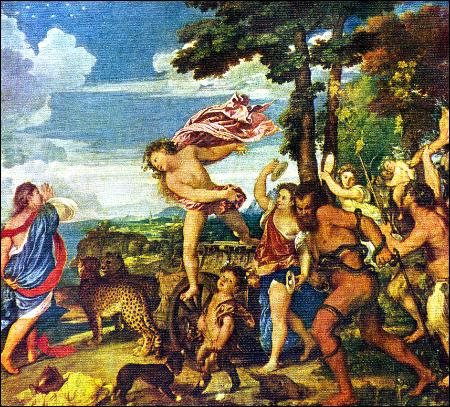
By Kind Permission of a Private Collection

By Kind Permission of a Private Collection
Bacchus and Ariadne was painted by Titian in 1522 and 1523 for the Studiolo of Alfonso d'Este of Ferrara. It was bought for the National Gallery, London, in 1826. According to Wethey, The Paintings of Titian: Complete Edition, Vol. 3, page 148, there is severe damage as a result of earlier attempts at restoration 'in the ultramarine sky of the upper left, where much of the original paint had already been replaced in earlier restorations.'
E.T.Cook described it as:
A picture which is at once a school of poetry and a school of art. It is a translation on canvas of that the scene described in Catullus, where Bacchus, the wine god, returning with his revel rout from a sacrifice, finds Ariadne on the sea shore, after she had been deserted by Theseus, her lover. Bacchus no longer sees her than he is enamoured and determines to make her his bride. ( Cook, Handbook to the National Gallery, including Notes Collected from the Works of Mr. Ruskin, p 145)
It is a picture which is considered in some detail in Reynolds on Titian, and in particular in Reynolds on Bacchus and Ariadne in Discourse Eight. Ruskin in Modern Painters I, without explicit reference to Reynolds, seems accept the substance of what Reynolds says about Titian's use of colour in Bacchus and Ariadne while challenging the implied judgements of value, both in his account of Bacchus and Ariadne and in his discussion of Titian's use of colour in his painting of San Pietro Martire. At MP I:198 Ruskin's account of Titian's foregrounds contrasts with what is said about the picture by Reynolds.
Wethey comments on the flower painting in Bacchus and Ariadne. Ruskin 's concern, here, as in MP I:xxx is with characteristics which separate one species from another, rather than the characteristics which separate one individual from another: on this see the discussion of general truths in MP I:59 ff.
Tiziano Vecellio (Titian) c.1490-1576
Bacchus and Ariadne 1522-3
Oil on canvas, 175.2x190.5cm
Collection: National Gallery, London